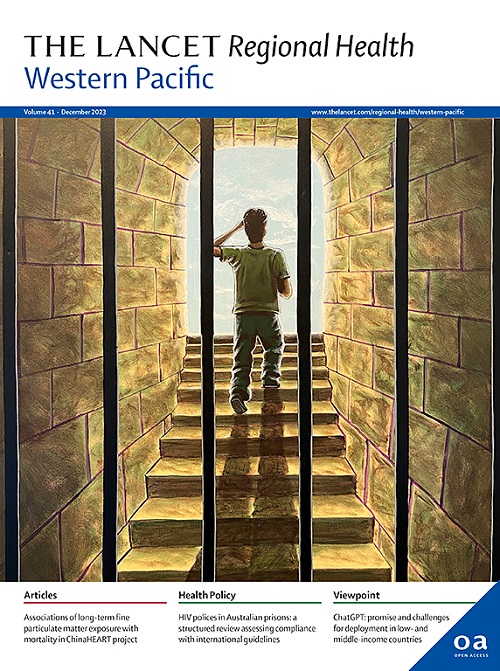年轻成人心力衰竭发病率、临床特征和结局的时间趋势:一项2014年至2023年对19537名患者进行的全港性研究
IF 8.1
1区 医学
Q1 HEALTH CARE SCIENCES & SERVICES
引用次数: 0
摘要
心衰(HF),传统上被认为是老年人的疾病,在年轻人中越来越常见,但时间数据仍然很少。本队列研究旨在研究年轻心衰患者发病率、合并症、危险因素概况和临床结果的时间趋势。方法使用香港的一个区域性行政数据库,我们确定了2014年至2023年期间发生心衰事件的19537名65岁年轻人。检索基线特征、超声心动图参数、合并症和处方药物的数据。通过直接年龄和性别标准化计算HF的年标准化发病率(IRs)。对2014-2018年和2019-2023年两个5年期进行了比较。应用多变量回归模型来评估风险因素概况的时间变化。主要结局是一年的全因死亡率,每100人年的发病率报告。绘制Kaplan-Meier生存曲线以说明生存趋势。在队列中(中位年龄57.1岁,69%为男性),从2014年到2023年,年轻HF的IRs增加了20% (IRR 1.20, 95% CI 1.13-1.27)。与2014-2018年队列中主要的传统危险因素(包括心脏骤停史)相比,2019-2023年的年轻HF患者更容易出现肥胖、心肌病、社会经济地位较低、年龄在45-65岁之间(p < 0.001)。此外,2019-2023年队列显示HF亚型升高,射血分数(HFrEF)降低,指南导向药物治疗(GDMT)的使用增加。在两个时期之间观察到一年死亡率的适度降低(每100人年15.6 [14.8,16.5]vs. 14.6[13.8, 15.5])。2014年至2023年间,年轻人心衰发病率大幅上升。在此期间,风险因素发生了相当大的变化,HFrEF亚型明显上升。尽管改善了治疗管理和更好地使用GDMT,但一年死亡率的降低幅度不大。迫切需要积极主动的公共卫生战略来应对这一人群中出现的这些新挑战。国家自然科学基金项目(No. 82270400)和广东省自然科学基金项目(No. 2023A1515010731)资助。本文章由计算机程序翻译,如有差异,请以英文原文为准。
Temporal trends in incidence, clinical characteristics and outcomes among young adults with heart failure: a territory-wide study from 2014 to 2023 on 19,537 patients
Background
Heart failure (HF), traditionally considered a disease of the elderly, is increasingly common in younger people, but temporal data remain scarce. This cohort study aimed to examine temporal trends in incidence, comorbidities, risk factor profiles, and clinical outcomes among young HF patients.
Methods
Using a territory-wide administrative database in Hong Kong, we identified 19,537 young adults aged <65 years with incident HF between 2014 and 2023. Data on baseline characteristics, echocardiographic parameters, comorbidities and prescribed medications were retrieved. Annual standardised incidence rates (IRs) of HF were calculated by direct age- and sex-standardisation. Comparisons were made between two 5-year periods: 2014–2018 and 2019–2023. Multivariable regression models were applied to assess temporal shifts in risk factor profiles. The primary outcome was one-year all-cause mortality, with incidence rates reported per 100 person-years. Kaplan–Meier survival curves were plotted to illustrate survival trends.
Findings
Among the cohort (median age 57.1 years, 69% men), IRs of young HF increased by 20% (IRR 1.20, 95% CI 1.13–1.27) from 2014 to 2023. Concurrent with fewer comorbidities, young HF patients in 2019–2023 were more likely to present with obesity, cardiomyopathy, lower socioeconomic status, and be aged 45–65 years, contrasting with the conventional risk factors (including history of sudden cardiac arrest) predominant in the 2014–2018 cohort (all p < 0.001). Additionally, the 2019–2023 cohort demonstrated elevated subtype of HF with reduced ejection fraction (HFrEF) and increased use of guideline-directed medical therapy (GDMT). A modest reduction in one-year mortality was observed between the two periods (15.6 [14.8, 16.5] vs. 14.6 [13.8, 15.5] events per 100 person-years).
Interpretation
The incidence of HF among young adults increased substantially between 2014 and 2023. During this period, the risk factor profile shifted considerably, with a pronounced rise in HFrEF subtype. Despite improved therapeutic management and better use of GDMT, reductions in one-year mortality were modest. Proactive public health strategies are urgently needed to address these emerging challenges in this population.
Funding
This work was funded by grants from the National Natural Science Foundation of China (No. 82270400) and the Natural Science Foundation of Guangdong Province (No. 2023A1515010731).
求助全文
通过发布文献求助,成功后即可免费获取论文全文。
去求助
来源期刊

The Lancet Regional Health: Western Pacific
Medicine-Pediatrics, Perinatology and Child Health
CiteScore
8.80
自引率
2.80%
发文量
305
审稿时长
11 weeks
期刊介绍:
The Lancet Regional Health – Western Pacific, a gold open access journal, is an integral part of The Lancet's global initiative advocating for healthcare quality and access worldwide. It aims to advance clinical practice and health policy in the Western Pacific region, contributing to enhanced health outcomes. The journal publishes high-quality original research shedding light on clinical practice and health policy in the region. It also includes reviews, commentaries, and opinion pieces covering diverse regional health topics, such as infectious diseases, non-communicable diseases, child and adolescent health, maternal and reproductive health, aging health, mental health, the health workforce and systems, and health policy.
 求助内容:
求助内容: 应助结果提醒方式:
应助结果提醒方式:


